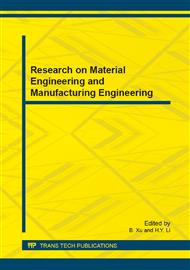[1]
HE Hongcheng, CHEN Chao. Study on composites based on lignocellulosic fibers[J]. Wood Processing Machinery. 2011(4): 30-35.
Google Scholar
[2]
Lu Lin, ZHANG Wenlin, ZENG Jingcheng. Natural fiber composites [M]. Chemical Industry. 2005, 10: 2-5.
Google Scholar
[3]
Kestur G. Satyanarayana, Gregorio G.C. Arizaga, Fernando Wypych. Biodegradable composites based on lignocellulosic fibers—An overview[J]. Progress in Polymer Science, 2009, 34: 982–1021.
DOI: 10.1016/j.progpolymsci.2008.12.002
Google Scholar
[4]
Mohanty A K, Mistra M, Drzal L T. Sustainable bio-composites from renewable resources: opportunities and chanllenges in the green materials world [J]. Journal of Polymers and the Environment, 2002, 10(1/2): 19-25.
DOI: 10.4324/9781315793245-107
Google Scholar
[5]
Marion Noel, Emmanuel Fredon, Eric Mougel, Daniel Masson, Eric Masson, Luc Delmotte. Lactic acid/wood-based composite material. Part 1: Synthesis and characterization[J]. Bioresource Technology 2009(100): 4711–4716.
DOI: 10.1016/j.biortech.2009.04.040
Google Scholar
[6]
HE Hongcheng, DENG Layun, CHEN Chao. Status of Timbers and Fibers Composites Research in USA[J]. World Forestry Research. 2012, 25(5): 70-75.
Google Scholar
[7]
Hiroyuki Kinoshita, Koichi Kaizu, Miki Fukuda, Hitoo Tokunaga, Keisuke Koga, Kiyohiko Ikeda. Development of green composite consists of woodchips, bamboo fibers and biodegradable adhesive[J]. Composites: Part B 2009 (40): 607–612.
DOI: 10.1016/j.compositesb.2009.04.004
Google Scholar
[8]
CHEN Yufang, CHUAI Chengzhi, XIE Laisu. The Development and Problems of the Composites of Plant Cellulose and Thermoplastics. Modern Plastics Processing and Applications. 1998, 10(2): 50-53.
Google Scholar
[9]
YANG Wenbing, HUANG Zutai, LI Jian. Study on Plant Fiber/Plastic Composites as the Motherboard of Floorboard. Fujian Agriculture and Forestry University Journal. 2005, 25(1): 10-13.
Google Scholar
[10]
HOU Xiuying, HUANG Zutai, YANG Wenbing. Application and Development of Plant Fiber in CompoundMaterial. Journal of Cellulose Science and Technology. 2005, 13(4): 55-59.
Google Scholar
[11]
ZHENG Yutao, CHEN Jiuji, CAO Derong. Technology Development on Improving Compatibility of Thermoplastics/Natural Fibers Composites. Journal of Cellulose Science and Technology. 2005, 13(1): 45-55.
Google Scholar


